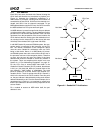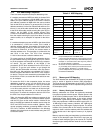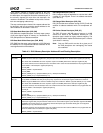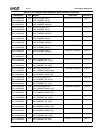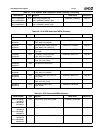
AMD Geode™ LX Processors Data Book 47
GeodeLink™ Interface Unit
33234H
4.1.2 Port Addressing Exceptions
There are some exceptions to the port addressing rules.
If a module accesses an MSR from within its closest GLIU
(e.g., CPU Core accessing a GLIU0 MSR), then, by con-
vention, the port address should be 0.0.0.0.0.0. But this
port address accesses an MSR within the source module
and not the GLIU as desired. To get around this, if the port
address contains a 0 in the first channel field and then con-
tains a 1 in any of the other channel fields, the access goes
to the GLIU nearest the module sourcing the cycle. By con-
vention, set the MSB of the second channel field,
0.4.0.0.0.0. If the MSR access is to a GLIU farther removed
from the module sourcing the cycle, then there is no con-
vention conflict, so no exception is required for that situa-
tion.
If a module attempts to access an MSR to the channel that
it is connected to, a GLIU error results. This is called a
reflective address attempt. An example of this case is the
CPU Core accessing 3.0.0.0.0.0. Since the CPU Core is
connected to Channel 3 of GLIU0, the access causes a
reflective address error. This exception is continued to the
next GLIU in the chain. The CPU Core accessing
2.1.0.0.0.0 also causes a reflective address error.
To access modules in the AMD Geode companion device,
the port address must go through the GLPCI (PCI control-
ler) in the processor and through the GLPCI in the compan-
ion device. The port address of the MSRs in the
processor’s GLPCI when accessed from the CPU Core is
2.4.0.0.0.0. To get the port address to go through the
GLPCI, the third field needs a non-zero value. By conven-
tion, this is a 2. We now have a port address of 2.4.2.0.0.0.
But this accesses the MSRs in the GLPCI in the compan-
ion device. The port to be accessed must be added in the
fourth field, 2.4.2.5.0.0, to access the AC97 audio bus mas-
ter, for example.
To access the GLIU in the companion device, the same
addressing exception occurs as with GLIU0 due to the
GLPCI’s address. A port address of 2.4.2.0.0.0 accesses
the companion device’s GLPCI, not the GLIU. To solve this,
a non-zero value must be in at least one of the two right-
most port fields. By convention, a 4 in the left-most port
field is used. To access the companion device’s GLIU from
the CPU Core, the port address is 2.4.2.0.0.4.
Table 4-2 shows the MSR port address to access all the
modules in a AMD Geode LX processor/CS5536 system
with the CPU Core as the source module. Included in the
table is the MSR port address for module access using the
GLCP and GLPCI as the source module. However, under
normal operating conditions, accessing MSRs is from the
CPU Core. Therefore, all MSR addresses in the following
chapters of this data book are documented using the CPU
Core as the source.
4.1.3 Memory and I/O Mapping
The GLIU decodes the destination ID of memory requests
using a series of physical to device (P2D) descriptors.
There can be up to 32 descriptors in each GLIU. The GLIU
decodes the destination ID of I/O requests using a series of
I/O descriptors (IOD).
4.1.3.1 Memory Routing and Translation
Memory addresses are routed and optionally translated
from physical space to device space. Physical space is the
32-bit memory address space that is shared between all
GeodeLink devices. Device space is the unique address
space within a given device. For example, a memory con-
troller may implement a 4 MB frame buffer region in the 12-
16 MB range of main memory. However, the 4 MB region
may exist in the 4 GB region of physical space. The actual
location of the frame buffer in the memory controller with
respect to itself is a device address, while the address that
all the devices see in the region of memory is in physical
space.
Memory request routing and translation is performed with a
choice of five descriptor types. Each GLIU may have any
number of each descriptor type up to a total of 32. The P2D
descriptor types satisfy different needs for various software
models.
Table 4-2. MSR Mapping
Destination
Source (Note 1)
Note 1. The xxxx contains the lower two bits of the 18 bits from
the port fields plus the 14-bit MSR offset.
CPU Core GLCP GLPCI
CPU Core 0000xxxxh 2C00xxxxh 2C00xxxxh
GLIU0 1000xxxxh 2000xxxxh 2000xxxxh
GLMC 2000xxxxh 2400xxxxh 2400xxxxh
GLIU1 4000xxxxh 1000xxxxh 1000xxxxh
GLCP 4C00xxxxh 0000xxxxh 6000xxxxh
GLPCI 5000xxxxh 8000xxxxh 0000xxxxh
DC 8000xxxxh 3000xxxxh 3000xxxxh
GP A000xxxxh 3400xxxxh 3400xxxxh
VP 4800xxxxh 4000xxxxh 3800xxxxh
VIP 5400xxxxh
Security Block 5800xxxxh
Companion
Device
51Y0xxxxh
(Note 2)
Note 2. Y is the hex value obtained from one bit (always a 0) plus
the port number (#) of the six port field addresses [0+#].
Example: # = 5, therefore the Y value is [0+101] which is
5h, thus the address = 5150xxxxh.
8ZK0xxxxh
(Note 3)
Note 3. ZK are the hex values obtained from the concatenation
of [10+#+000], where # is the port number from the six
port field address. Example # = 5, the ZK value is
[10+101+000] which is [1010,1000]. In hex. it is A8h; thus
the address is 8A80xxxxh.
NA










